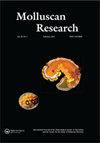印度西高止山脉Haploptychius属一新种Möllendorff, 1906(柱头虫目:链蝇科)
IF 0.6
4区 生物学
Q3 ZOOLOGY
引用次数: 0
摘要
摘要本文描述了来自印度马哈拉施特拉邦西高止山脉北部的链状蜗牛属Haploptychius的一个新种,这是该属第三个来自印度的成员。sahyadriensis n. sp.与其他印度和东南亚的haploptychus sp.的区别在于具有近斜螺旋形外壳,低尖顶和存在一个强大的顶板。该新种具有独特的生殖器解剖结构,有长阴茎,有阴茎鞘,有阴茎阑尾,有阴茎钩,心房和阴道分别有纵脊和不规则横脊,但没有任何钩。在阴道、配子体导管和游离输卵管交界处附近有一块有光泽的肌肉。根据壳形态和生殖特征,该新种归属于Haploptychius属。我们的研究表明,在西高止山脉北部的其他未开发地区可能潜藏着更多未描述的陆地蜗牛物种,这些物种可能是地方性的。出版物LSID: LSID: http://zoobank.org:pub:18C6E99C-6FDE-46A6-8E12-EB834D588910本文章由计算机程序翻译,如有差异,请以英文原文为准。
A new species of Haploptychius Möllendorff, 1906 (Stylommatophora: Streptaxidae) from the Western Ghats, India
ABSTRACT We here describe a new species of the streptaxid snail genus Haploptychius from the northern Western Ghats of Maharashtra, which is the third member of the genus from India. Haploptychius sahyadriensis n. sp. is distinguished from the other Indian and South-East Asian Haploptychius sp. in having suboblique-heliciform shell, low spire and presence of one strong parietal lamella. The new species has unique genital anatomy in having a long penis with a penial sheath, the presence of penial appendix, penial hooks, atrium and vagina with longitudinal ridges and irregular transverse ridges respectively, but without any hooks. It bears a shiny muscle near the junction of the vagina, gametolytic duct and the free oviduct. Based on the shell morphology and genital characters, the new species is placed in the genus Haploptychius. Our study reveals that other unexplored areas in the northern Western Ghats may potentially harbour more undescribed land snail species which could be endemic. Publication LSID: lsid:http://zoobank.org:pub:18C6E99C-6FDE-46A6-8E12-EB834D588910
求助全文
通过发布文献求助,成功后即可免费获取论文全文。
去求助
来源期刊

Molluscan Research
生物-动物学
CiteScore
1.80
自引率
10.00%
发文量
27
审稿时长
>12 weeks
期刊介绍:
Molluscan Research is an international journal for the publication of authoritative papers and review articles on all aspects of molluscan research, including biology, systematics, morphology, physiology, ecology, conservation, biogeography, genetics, molecular biology and palaeontology.
While the scope of the journal is worldwide, there is emphasis on studies relating to Australasia and the Indo-west Pacific, including East and South East Asia. The journal’s scope includes revisionary papers, monographs, reviews, theoretical papers and briefer communications. Monographic studies of up to 73 printed pages may also be considered.
The journal has been published since 1957 (as the Journal of the Malacological Society of Australia until 1993). It is free to members of the Malacological Society of Australasia and the Society for the Study of Molluscan Diversity.
 求助内容:
求助内容: 应助结果提醒方式:
应助结果提醒方式:


